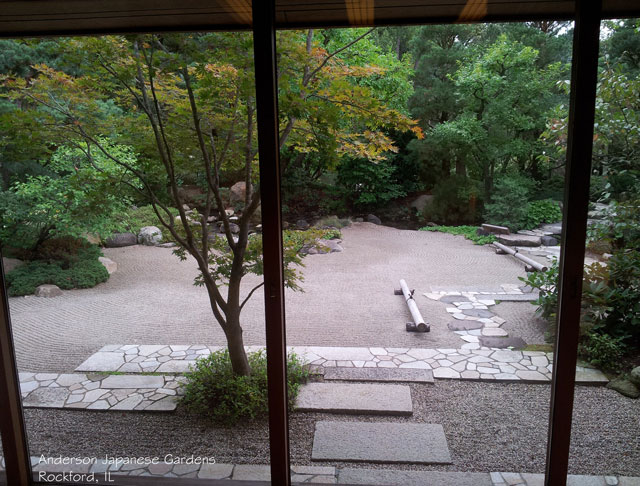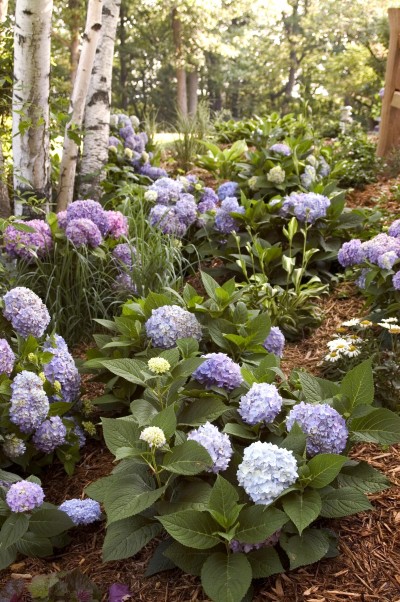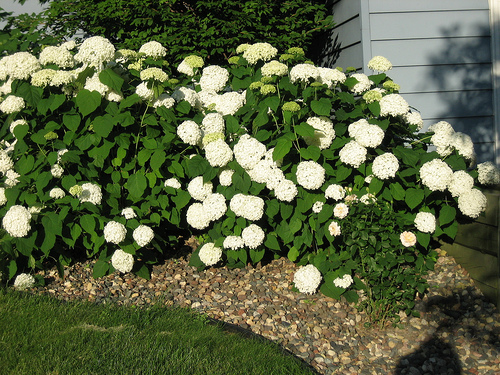Last post, I wrote about trees that landscapers love to use. Today, I wanted to start talking about shrubs.
If I had one word to sum up what I have learned about shrubs since working for a top residential landscaper in my area. That word would be….
wait for it….
Hydrangea!
Sure there are some shrubs that are more popular than any of the hydrangea’s. As a group, I don’t think any are. Well except maybe Viburnums.
Summer blooms are hot. People enjoy their yards in the Summer and they want to see flowers then. Hydrangeas are great shrubs for Summer blooms.
I came late to the party. At Anderson Gardens the focus of the plantings is really on showing the seasons. Spring blooms, cool greens in the summer, and blazing fall color in the Autumn.

Yes we did have some summer blooms at Anderson Gardens. This even included more than a few Hydrangea in Garden of Reflection. I also am quite a fan of the one hydrangea I have in my yard, the Oakleaf hydrangea. I still didn’t realize how popular these were.
So today we are going to get stuck on one shrub, the Hydrangea. I’ll still talk about the other shrubs landscapers love in upcoming posts.
So what are some of landscapers favorite hydrangeas, at least in the Midwest US where I call home?
#1 Big Leaf Hydrangea
Endless Summer Hydrangea® (Hydrangea macrophylla ‘Bailmer’)
This was the first repeat blooming Bigleaf Hydrangea. This brought new life into the hipness of the hydrangea and instantly became one of landscapers favorite hydrangeas. When a cold winter used to kill Bigleaf hydrangeas to the ground, you would lose the only flower buds the plant would have for that next summer.
Then this plant came along and showed that you could have a Bigleaf hydrangea blooms on NEW growth. Not only would you get flowers even after bad winters, you would get repeat blooms!
This was a BIG deal and thus the plant became a BIG hit.


Wildlife Value: This shrub is native to Japan. Endless Summer is a “mophead” form of Bigleaf hydrangea that has very little wildlife value as it has mostly sterile flowers and is a non native.
Sun Exposure: Partial Shade
Soil: Well-drained, moist soil
Size: 3-4′ wide / 4-5′ tall
Hardiness: Zone 4 – 9
Twist and Shout Hydrangea® (Hydrangea macrophylla ‘PIIHM-I’)
This is the first re-blooming “lacecap” Big leaf hydrangea. Strong stems and glossy green leaves turn red-burgundy in Autumn to give year around interest in the garden. This hydrangea also produces blooms on both old and new wood all summer long.

“Lacecaps “are identical to “mopheads” in every way except the shape of their blooms. The little buds in the center of the lacecap are the fertile flowers, and the large showy blossoms around the outer edge are the sterile flowers.

Wildlife Value: Probably a little. Like Endless Summer, Twist and Shout is a non native. It may, however, produce some pollen to attract pollinators like most “lacecaps” hydrangeas.
Sun Exposure: Partial Shade
Soil: Well-drained, moist soil
Size: 3-5′ wide by 3-5′ tall.
Hardiness: Zone 4
#2 Panicle hydrangea
Panicle hydrangea is a fast-growing shrub that can reach 20 feet high and wide. It can be trained as a small tree, but many newer cultivars remain compact. Panicle hydrangea is a tough, adaptable plant that grows best in zones 4 to 8. It can tolerate harsher urban environments and drier soil conditions than most other hydrangeas.
Blooms occurs on it’s current season’s growth, so you can prune as needed in late winter to early spring.
PeeGee Hydranea (Hydrangea paniculata ‘Grandiflora’)
‘Grandiflora’ is usually called Peegee hydrangea. It is a vigorous, upright growing, coarsely textured, shrub which grows 10-25′ tall.
It has conical flower panicles that are typically 6-8″ long and have mostly sterile florets.
It is sometimes seen in a tree form where it trained to a single stem with a head.

Tardiva Hydrangea (Hydrangea paniculata ‘Tardiva’ )
This is a larger selection that grows 6-10′ wide and tall. It is more open and airy then ‘PeeGee’, It is rarely fed on by Japanese beetles.

Limelight Hydrangea (Hydrangea paniculata ‘Limelight’)
‘Limelight’ is the standard of medium sized cultivars. It bears bright, lime-green flowers, that add a freshness to the late Summer landscape. In fall, the blooms turn shades of pink, burgundy and green. It is also supposedly extremely resistant to Japanese Beetles.

Wildlife Value: This shrub is native to Japan and China. It also has very little wildlife value.
Sun Exposure: Full Sun to Partial Shade
Soil: Well-drained, moist soil
Size: 6-8′ wide by 6-8′ tall.
Hardiness: Zone 3-8
Perhaps you like limelight but want something a bit more compact. Little Lime® Hydrangea (Hydrangea paniculata ‘Jane’) shares many of it’s namesake characteristics, but only grows 3-5′ wide and tall. It seems to be becoming one of landscapers favorite hydrangeas.
#3 Smooth hydrangea
(Hydrangea arborescens)
Smooth hydrangea is a native hydrangea. It is native from New York to Florida west to between Iowa and Louisiana.
Smooth hydrangeas grow into clumps about 4′ by 4′. Flowers can be very large globes that bloom in early Summer in the South to Mid Summer further North. Bloom time can be up to two months and flowers can be so big and heavy that they cause the branches to flop over. It blooms on current seasons growth.
This hydrangea is often treated as an herbaceous perennial and cut to the ground every winter
Many smooth hydrangea selections are available. ‘Grandiflora’ was the standard for many years, but it has been replaced by ‘Annabelle.’


‘Annabelle’ features somewhat stronger stems than ‘Grandiflora,’ but they can still be floppy. ‘Annabelle’ is a naturally occurring cultivar which was discovered in the wild near Anna, Illinois.
A new selection, ‘Incrediball’, has bigger flowers than either of those two.

Wildlife Value: Unlike several of the Hydrangea’s that have mostly sterile flowers, H. arborescens provides food for a variety of bees, ants, beetles, flies and butterflies. This native plant is a host to the Hydrangea sphinx (Darapsa versicolor) which is native to the eastern half of the US and I bet is mighty tasty if you are a bird looking for a bit of protein.
Sun Exposure: Full Sun (with adquate watering) to Partial Shade
Soil: Well-drained, moist soil. Does not tolerate drought. Will need more water the more sun it gets.
Size: 3-6′ wide by 3-6′ tall.
Hardiness: Zone 3-8
#4 This Landscaper’s favorite Hydrangea, the Oakleaf
Oakleaf Hydrangea (Hydrangea quercifolia)
This is last on my list, but would be the first one I pick up at a nursery. I have talked about this native hydrangea before (Oakleaf Hydrangea for long Summmer blooms), so I won’t go into detail here.
It is a great shrub worth adding to any garden that is looking for four season interest. It also looks great in natural style gardens and woodlands.




Perhaps you can find a spot in your garden where a hydrangea or two can provide some summer blooms to liven up your Summer landscape.
Next time we will take a look at some of the other popular shrubs among landscapers.
Nicole Gordon says
We bought a property with three lace cap hydrangeas along the driveway. The shrubs are an enormous attractor of bees — especially bumble and honey bees, with what seems (and sounds) like hundreds in early July mornings.
Doug Lyons says
Hi Jim ! I enjoy your articles, this one on hydrangeas I have a question and maybe you can help.. I planted two hydrangeas several years ago and when I purchased them from a local nursery they were full of bloom but every since each year they produce lots of green leaves but no blooms. I have asked many nursery people about this problem and some say I should cut the dead back in the fall.. So I tried that sill no blooms others said let the dead stay. So I tried that still no blooms about three summers ago I had one bloom. Have not had any before or since. I planted these back in the summer of 2000. Again lots of green but not bloom and I am not sure what kind of hydrangea they are but beautiful green leaves. Can you help? Thanks Doug
Jim says
I would recommend fertilizing with a higher phosphorous and lower nitrogen fertilizer to encourage blooms. Any fertilizer that has blooms in the name is probably fine.